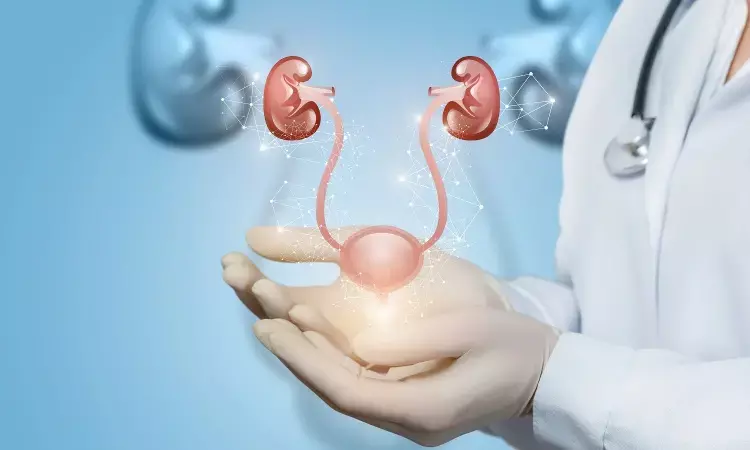- Home
- Medical news & Guidelines
- Anesthesiology
- Cardiology and CTVS
- Critical Care
- Dentistry
- Dermatology
- Diabetes and Endocrinology
- ENT
- Gastroenterology
- Medicine
- Nephrology
- Neurology
- Obstretics-Gynaecology
- Oncology
- Ophthalmology
- Orthopaedics
- Pediatrics-Neonatology
- Psychiatry
- Pulmonology
- Radiology
- Surgery
- Urology
- Laboratory Medicine
- Diet
- Nursing
- Paramedical
- Physiotherapy
- Health news
- Fact Check
- Bone Health Fact Check
- Brain Health Fact Check
- Cancer Related Fact Check
- Child Care Fact Check
- Dental and oral health fact check
- Diabetes and metabolic health fact check
- Diet and Nutrition Fact Check
- Eye and ENT Care Fact Check
- Fitness fact check
- Gut health fact check
- Heart health fact check
- Kidney health fact check
- Medical education fact check
- Men's health fact check
- Respiratory fact check
- Skin and hair care fact check
- Vaccine and Immunization fact check
- Women's health fact check
- AYUSH
- State News
- Andaman and Nicobar Islands
- Andhra Pradesh
- Arunachal Pradesh
- Assam
- Bihar
- Chandigarh
- Chattisgarh
- Dadra and Nagar Haveli
- Daman and Diu
- Delhi
- Goa
- Gujarat
- Haryana
- Himachal Pradesh
- Jammu & Kashmir
- Jharkhand
- Karnataka
- Kerala
- Ladakh
- Lakshadweep
- Madhya Pradesh
- Maharashtra
- Manipur
- Meghalaya
- Mizoram
- Nagaland
- Odisha
- Puducherry
- Punjab
- Rajasthan
- Sikkim
- Tamil Nadu
- Telangana
- Tripura
- Uttar Pradesh
- Uttrakhand
- West Bengal
- Medical Education
- Industry
Rare case of Fungal Ball in Urinary Bladder reported in NEJM

Dr Chieh-Ying Chang and Ming-Han Hsieh have reported a rare case of fungal ball in Urinary Bladder that has been published in New England journal of Medicine.
Fungus balls or fungal bezoars in the urinary bladder is extremely rare disease and most common predisposing factor for this opportunistic infection is diabetes mellitus.
Most common cause of fungus ball formation is albicans and other Candida species, Aspergillus, Penicillium, and Mucorales fungus balls have also been reported
According to history a 68-year-old man with type 2 diabetes presented to the emergency department with a 3-day history of dysuria, intermittent hematuria, and the passage of small balls in his urine with straining. He reported no fever, chills, or flank pain. Three months before presentation, he had started treatment with a sodium-glucose cotransporter 2 (SGLT2) inhibitor.
The results of a physical examination were normal. A urine specimen contained a white ball measuring 1.5 cm in diameter (Panel A). Laboratory studies showed a glycated hemoglobin value of 7.8% (reference range, 4 to 6), and a urinalysis revealed glucosuria, pyuria, hematuria, and the presence of yeast. An ultrasound examination showed a 2-cm mobile mass on the bladder floor (Panel B). A urine culture grew Candida albicans, and a diagnosis of candida cystitis with fungal balls was made.
Patients with type 2 diabetes are at increased risk for genitourinary infections, and SGLT2 inhibitors may further augment this risk by increasing the degree of glycosuria. This drug class has been more frequently associated with genital mycotic infections, such as candida vaginitis and balanitis, than with fungal urinary tract infections. Treatment with fluconazole was initiated, and the SGLT2 inhibitor therapy was discontinued. Cystoscopy was not performed. At the 4-week follow-up visit, the patient's symptoms had abated.
Reference:
Fungal Ball in the Urinary Bladder. Chieh-Ying Chang, M.D., and Ming-Han Hsieh, M.D. July 2, 2022 DOI: 10.1056/NEJMicm2114684
Dr Kamal Kant Kohli-MBBS, DTCD- a chest specialist with more than 30 years of practice and a flair for writing clinical articles, Dr Kamal Kant Kohli joined Medical Dialogues as a Chief Editor of Medical News. Besides writing articles, as an editor, he proofreads and verifies all the medical content published on Medical Dialogues including those coming from journals, studies,medical conferences,guidelines etc. Email: drkohli@medicaldialogues.in. Contact no. 011-43720751


